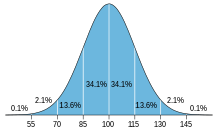Loading AI tools


An intelligence quotient (IQ) is a metric to measure human intelligence.
| This theme article is a stub. You can help out with Wikiquote by expanding it! |
- Eager to measure human minds, Terman plunged into intelligence testing soon after he arrived at Stanford. The original intelligence test had been designed five years earlier by French psychologist Alfred Binet as a tool to identify "slow" children needing special help. Terman and his Stanford colleagues translated Binet's test, adapted the content for U.S. schools, set new age norms and standardized the distribution of scores so that the mean score would always be 100. Terman called the new version the Stanford-Binet test.
With questions ranging from mathematical problems to vocabulary items, the Americanized test was supposed to capture "general intelligence," an innate mental capability that Terman felt was as measurable as height and weight. As a hardcore hereditarian, he believed that genetics alone dictated one's level of general intelligence. This vital constant, which he called an "original endowment," wasn't altered by education or home environment or hard work, he maintained. To denote it, he selected the term "intelligence quotient."- Mitchell Leslie, “The Vexing Legacy of Lewis Terman”, Stanford Magazine, (JULY/AUGUST 2000)
Wikiwand in your browser!
Seamless Wikipedia browsing. On steroids.
Every time you click a link to Wikipedia, Wiktionary or Wikiquote in your browser's search results, it will show the modern Wikiwand interface.
Wikiwand extension is a five stars, simple, with minimum permission required to keep your browsing private, safe and transparent.
